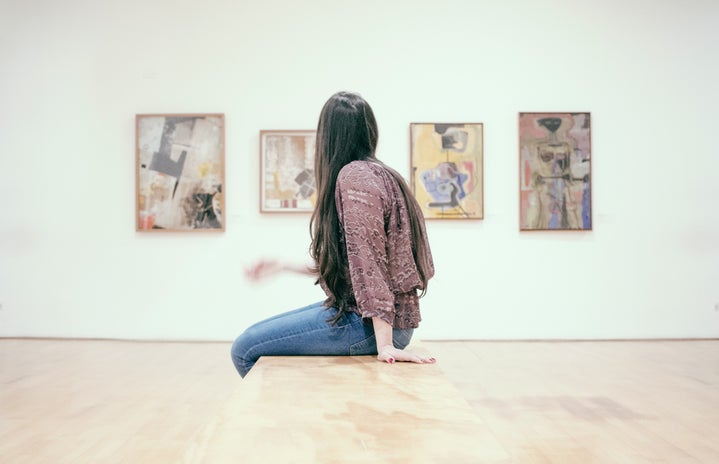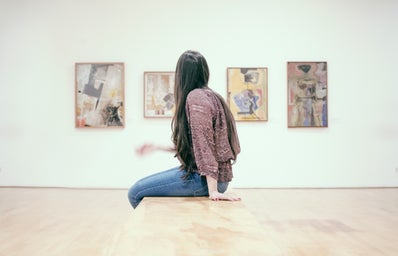Waiting for my flight back home for winter break, I had the opportunity to spend a couple of hours at Terminal C of John Wayne Airport. On display at the terminal’s Vi Smith Gallery was No Touching, a collection of various tactile art pieces (I remember knitted objects) encased in glass, whether a glass box on a pedestal or a pane in front of a wall-mounted work. I thought the exhibit was clever. Indeed, the airport uses that exact word, “clever,” to describe the collection in its press release. However, I soon found other ways to entertain myself and later boarded for Sacramento, the exhibit not occupying much space in my mind.
I remembered No Touching again when the next quarter started and Humanities Core introduced its focus for the term: art analysis. Not usually interested much in visual art analysis, I surprised myself by having lots of fun with both of this quarter’s essays, one about a photograph and one about a film, so I decided to share some of the thoughts that have been in the back of my head since I viewed No Touching. In particular, I think that its dynamic of present-but-unreachable matches that between a viewer and a digital archive (image, video), a practically flat representation of tactile things. Its “cleverness” in this way should bring scrutiny to exactly why we see it as clever and how we might deal with those reasons.
The connection between No Touching and electronic devices manifests readily in their comparable uses of screens. No Touching places its works behind screens of glass; a phone places its works behind a smaller screen of glass. The viewer stands separated from what they are viewing even as they extract meaning from it. As the name of the exhibit states, the average person will never be able to touch the displayed works, nor the vast majority of what they see in images and videos on the internet. The screen is flat. It makes no difference whether what is behind it actually resides a few feet from us or miles away—to us, the things behind glass are all at a distance and therefore all unreal. They are simulacra of, at the very least, moments we can never touch again.
We tend to believe that the advent of global communication and rapid sharing lets us see the entire world in a manner practically impossible for those without an internet connection. Why, then, does an exhibit like No Touching “cleverly” taunt us? In truth, we want to feel things. Watching a beautiful sunset through someone else’s camera has negligible impact on us compared to the visceral experience of actually sitting on the beach as the sky goes out. Distanced things resist not only being touched but also touching us. Perhaps the real cleverness of the exhibit is its sitting in an airport, where people travel to and from actual spatial experiences. “Keep walking down to your gate,” it says, “so you can feel the world instead of being stuck here looking at me. Go into the sky, get closer to the rest of the universe.”
Although the exhibit closed last week, you can see many of its component works in this behind-the-scenes video. Putting aside the humor of viewing items being put behind screens on a screen, the existence of the video makes obvious a fundamental truth of the digital age: everything can be made eternal. An artistic work in all its essence can be better recorded for us, forever, by a computer than by our own senses and memory. The screen eliminates only touch, smell, and taste; sight and sound are completely intact if handled properly. From the perspective of faithfulness, the visual and auditory aspects of an original piece are obsolete after they are recorded digitally. We stumble upon an interesting proposal ironically made possible only by the internet: art, if its physical existence does not hold value to the artist, should be touched and worn away.
Through this proposal, we can reap the benefits of being able to experience art through touch. Noah Purifoy, who displayed his art in the open Mojave Desert, felt freed by the fact that the harsh weather would degrade his pieces, making his art much less permanent than those in the museum case. Rather than seeing art as sacred, not to be defiled by viewer touch, we should see it as a vessel for meaning that, even if it degrades in the process, should be experienced as fully as it can by others. New art is being created at every moment; should we not, while getting substantially more valuable out of them by tactile experience, make room for new art by eventually destroying the old? As art exists to touch and be touched by living things, and as touching is infinitely more valuable than looking while only wearing away a piece in minuscule, we should prioritize letting people feel art with more than just their eyes.


